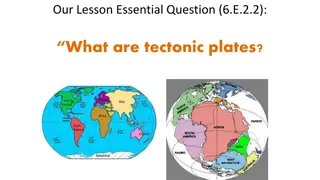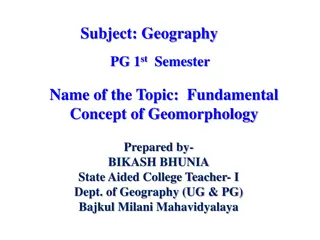The Components and Types of Environmental Pollution
The environment comprises abiotic and biotic elements, including the atmosphere, hydrosphere, lithosphere, and biosphere. Different types of pollution, such as air, water, land/soil, noise, and thermal pollution, pose significant threats to human health and the environment. Awareness of these pollut
1 views • 17 slides
Geography: Earth's Description and Study
Geography, coined by Greek scholar Eratosthenes, encompasses the description and explanation of Earth's surface differentiation. It involves physical and human aspects, with branches like geomorphology, climatology, and economic geography. Physical geography studies the lithosphere, atmosphere, hydr
0 views • 6 slides
Land, Soil, and Water Resources
Natural resources such as land, soil, and water are crucial for human activities. Land comprises the lithosphere and is utilized for various purposes based on land use patterns. The study of land use patterns is essential for economic planning, as the availability of land is limited, leading to conf
5 views • 25 slides
Components of the Environment in Social Science Chapter 1
The components of the environment play a crucial role in supporting life on Earth. The natural environment consists of physical and biological components that are interdependent. The Earth can be divided into four spheres: hydrosphere, biosphere, atmosphere, and lithosphere. The lithosphere, made of
3 views • 16 slides
Earthquakes and Volcanoes: a Comprehensive Overview
Earthquakes are vibrations in the ground caused by movement along faults in the Earth's lithosphere. They occur mostly near plate boundaries and are difficult to predict. Different types of faults and seismic waves play a crucial role in understanding these natural phenomena. Seismologists study ear
0 views • 19 slides
Processes Shaping Earth: Lithosphere, Plate Tectonics, and Effects
Explore the components of our planet, such as the lithosphere, hydrosphere, atmosphere, and biosphere. Learn how the lithosphere, consisting of the Earth's crust and top solid mantle, interacts through plate tectonics, causing movements that shape the Earth's surface. Discover the concept of Pangaea
0 views • 31 slides
Tectonic Plates and Earth's Layers
Explore the composition of Earth's layers through classifying them based on chemical and physical properties. Learn about the lithosphere and its role, including the movement of tectonic plates on the asthenosphere. Discover the distinctions between oceanic and continental plates, their thickness va
1 views • 22 slides
Earth's Interior Composition and Magma Generation
The Earth's interior comprises the lithosphere, asthenosphere, outer core, and inner core, heated by radioactive decay and residual heat. The lithosphere is rigid, while the asthenosphere beneath can flow plastically. Magma is generated at mid-ocean ridges, hotspots, and subduction zones, where plat
1 views • 8 slides
Ecosystems: Components and Interactions
Ecosystems are dynamic systems where abiotic and biotic components interact to sustain life. Ecology studies these interactions, including nutrient cycling and energy flow. The biosphere, comprising the atmosphere, hydrosphere, lithosphere, and living organisms, forms Earth's life-support system. Ec
0 views • 22 slides
Natural Vegetation and Wildlife Resources
Natural vegetation and wildlife play a crucial role in the biosphere, providing essential resources and maintaining ecological balance. The interaction between the lithosphere, hydrosphere, and atmosphere creates the biosphere where living organisms thrive. Plants offer timber, oxygen, and other val
0 views • 16 slides
The Earth's Environmental Systems and Cycles
Explore the interconnected systems of the Earth's biosphere, lithosphere, hydrosphere, and atmosphere, along with biogeochemical cycles like the hydrological cycle. Learn how these systems interact to sustain life and maintain Earth's dynamic environment over billions of years.
1 views • 28 slides
Rocks: Types, Formation, and Importance in Geology
Rocks are solid accumulations of minerals found in the Earth's lithosphere. They are classified into igneous, sedimentary, and metamorphic types based on their mineral composition. Rocks play a crucial role as geological materials for construction and historical buildings. Learn about the properties
1 views • 31 slides
The Fascinating World of Geology and Earth Sciences
Delve into the diverse field of geology, covering topics such as physical and historical geology, geochronology, mineralogy, petrology, and more. Learn about the solar nebula hypothesis and the Earth's lithosphere, hydrosphere, atmosphere, and biosphere. Discover the composition of Earth's atmospher
0 views • 12 slides
Plate Tectonics and Earth's Crust
Explore the differences between oceanic and continental crust, the distinctions of lithosphere and asthenosphere, the dynamics of convergent and divergent boundaries, as well as the concepts of folding and faulting in geological formations. Delve into the characteristics of oceanic crust versus ocea
0 views • 10 slides
The Theory of Plate Tectonics: Continents in Motion
Earth's crust and lithosphere have changed over geologic time, forming tectonic plates that move due to convection currents. The concept of plate tectonics explains how continents fit together, the existence of a supercontinent called Pangaea, and natural phenomena like earthquakes and mountains. Ea
0 views • 28 slides
Plate Boundaries: Convergent, Divergent, and Transform Faulting
Delve into the world of plate boundaries by understanding convergent, divergent, and transform faulting. Discover various examples worldwide, describing their physical locations, major tectonic plates involved, resulting landforms, lithosphere types, and associated catastrophic events. Learn about t
0 views • 5 slides
Fundamental Concepts of Geomorphology: Exploring Earth Forms and Evolution
Geomorphology, derived from Greek roots for earth and study, focuses on the origin and evolution of Earth's surface features. Geomorphologists study landforms above sea level and the interface between solid Earth, Hydrosphere, atmosphere, and Lithosphere. The fundamental concepts of geomorphology in
0 views • 12 slides
Introduction to Ecology and Environment Studies
Ecology is the study of the relationship between organisms and their environment, while the environment refers to the surroundings that influence living organisms. The biosphere is divided into the atmosphere, lithosphere, and hydrosphere. Terms in ecology include species, populations, communities,
0 views • 13 slides
Introduction to Earth Systems in GEO101 Spring 2023
Explore the fundamental concepts of Earth systems in GEO101 Spring 2023, covering the components, linkages, states, and examples of systems such as Atmosphere, Lithosphere, Hydrosphere, and Biosphere. Gain insight into the interconnections and dynamics of these systems to understand the complexity o
0 views • 30 slides
The Hydrological Cycle in Advanced Agro-Hydro-Meteorology
The hydrological cycle involves the continuous movement of water on, above, and below the Earth's surface, encompassing various realms such as the biosphere, atmosphere, cryosphere, lithosphere, and hydrosphere. This cycle describes the storage and movement of water within different Earth systems an
0 views • 14 slides
Journey Through Earth's Physical Geography: A Living Planet
Explore the intricate layers of the Earth, from the core made of iron and nickel to the diverse environments of the lithosphere, hydrosphere, atmosphere, and biosphere. Learn about continental drift and the formation of the supercontinent Pangea in this fascinating overview of our dynamic planet.
0 views • 7 slides
The Components and Importance of Environment
Explore the different components of the environment such as flora, fauna, lithosphere, hydrosphere, atmosphere, and biosphere. Understand the dependency of human beings on the environment, the impact of environmental degradation, and the concept of sustainable development. Learn how we can conserve
0 views • 8 slides
The Importance of Soil Systems
Soils play a vital role in the Earth's ecosystems by forming at the interface of various elements like the atmosphere, lithosphere, biosphere, and hydrosphere. They consist of weathered bedrock, organic matter, air, and water, making them essential for sustaining life. Soil interactions with differe
0 views • 36 slides
Earth's Composition and Structure
Delve into the depths of Earth's layers from the crust to the core, learning about its compositional and structural zones. Discover the significance of seismic waves in unraveling the mysteries of Earth's interior, and grasp the fundamental concepts behind the planet's lithosphere and asthenosphere.
0 views • 47 slides
Earth's Internal Structure: A Geographical Perspective
Deep parts of Earth's interior are studied indirectly through geophysics, including seismic waves, magnetic fields, gravity, and heat. Seismic studies reveal Earth's layers - crust, mantle, and core - each with distinct properties and compositions. The lithosphere, comprising the upper mantle and cr
0 views • 12 slides
Earth's Layers: Vocabulary Flashcards
Explore essential vocabulary related to Earth's structure through informative flashcards depicting key terms such as Inner Core, Mantle, Lithosphere, Tectonic Plate, Outer Core, and more. Enhance your knowledge of the planet's composition and geology.
0 views • 26 slides
The Theory of Continental Drift and Plate Tectonics
Scientist Alfred Wegener proposed the theory of continental drift, noticing how continents could fit together like pieces of a puzzle. His idea evolved into the concept of plate tectonics, explaining the movement of Earth's lithosphere. This model highlights the dynamic nature of the Earth's surface
0 views • 4 slides
Comprehensive Overview of Oceanography
Oceanography is a fascinating and interdisciplinary scientific field that encompasses the study of seas and oceans. It covers topics such as geography, geology, chemistry, physics, biology, climatology, and engineering. Oceanography is subdivided into geological, physical, chemical, and biological b
1 views • 24 slides



























